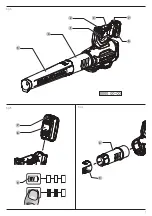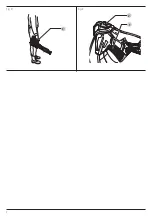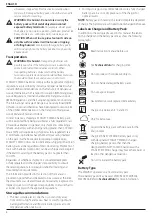
7
English
Charging a Battery (Fig. B)
1. Plug the charger into an appropriate outlet before inserting
battery pack.
2. Insert the battery pack
7
into the charger, making sure the
battery pack is fully seated in the charger. The red (charging)
light will blink repeatedly indicating that the charging
process has started.
3. The completion of charge will be indicated by the red light
remaining ON continuously. The battery pack is fully charged
and may be used at this time or left in the charger. To
remove the battery pack from the charger, push the battery
release button
8
on the battery pack.
nOTE:
To ensure maximum performance and life of lithium-ion
battery packs, charge the battery pack fully before first use.
Charger Operation
Refer to the indicators below for the charge status of the
battery pack.
Charge Indicators
Charging
Fully Charged
Hot/Cold Pack Delay*
*
The red light will continue to blink, but a yellow indicator light
will be illuminated during this operation. Once the battery pack
has reached an appropriate temperature, the yellow light will
turn off and the charger will resume the charging procedure.
The compatible charger(s) will not charge a faulty battery pack.
The charger will indicate faulty battery by refusing to light or by
displaying problem pack or charger blink pattern.
nOTE:
This could also mean a problem with a charger.
If the charger indicates a problem, take the charger and battery
pack to be tested at an authorised service centre.
hot/Cold Pack Delay
When the charger detects a battery pack that is too hot or too
cold, it automatically starts a Hot/Cold Pack Delay, suspending
charging until the battery pack has reached an appropriate
temperature. The charger then automatically switches to the
pack charging mode. This feature ensures maximum battery
pack life.
A cold battery pack will charge at a slower rate than a warm
battery pack. The battery pack will charge at that slower rate
throughout the entire charging cycle and will not return to
maximum charge rate even if the battery pack warms.
Wall Mounting
These chargers are designed to be wall mountable or to sit
upright on a table or work surface. If wall mounting, locate the
charger within reach of an electrical outlet, and away from a
corner or other obstructions which may impede air flow. Use
the back of the charger as a template for the location of the
mounting screws on the wall. Mount the charger securely using
drywall screws (purchased separately) at least 25.4 mm long
with a screw head diameter of 7–9 mm, screwed into wood to
an optimal depth leaving approximately 5.5 mm of the screw
exposed. Align the slots on the back of the charger with the
exposed screws and fully engage them in the slots.
Charger Cleaning Instructions
WARNING: Shock hazard. Disconnect the charger
from the AC outlet before cleaning
. Dirt and grease
may be removed from the exterior of the charger using a
cloth or soft non-metallic brush. Do not use water or any
cleaning solutions. Never let any liquid get inside the tool;
never immerse any part of the tool into a liquid.
Battery Packs
Important Safety Instructions for All Battery
Packs
When ordering replacement battery packs, be sure to include
catalogue number and voltage.
The battery pack is not fully charged out of the carton. Before
using the battery pack and charger, read the safety instructions
below. Then follow charging procedures outlined.
READ ALL INSTRUCTIONS
•
Do not charge or use battery in explosive atmospheres,
such as in the presence of flammable liquids, gases or
dust.
Inserting or removing the battery from the charger may
ignite the dust or fumes.
•
Never force battery pack into charger. Do not modify
battery pack in any way to fit into a non-compatible
charger as battery pack may rupture causing serious
personal injury.
• Charge the battery packs only in STANLEY FATMAX chargers.
•
DO NOT
splash or immerse in water or other liquids.
•
Do not store or use the tool and battery pack in
locations where the temperature may reach or exceed
40 ˚C (104 ˚F) (such as outside sheds or metal buildings
in summer).
•
Do not incinerate the battery pack even if it is severely
damaged or is completely worn out.
The battery pack can
explode in a fire. Toxic fumes and materials are created when
lithium-ion battery packs are burned.
•
If battery contents come into contact with the skin,
immediately wash area with mild soap and water.
If
battery liquid gets into the eye, rinse water over the open eye
for 15 minutes or until irritation ceases. If medical attention
is needed, the battery electrolyte is composed of a mixture of
liquid organic carbonates and lithium salts.
•
Contents of opened battery cells may cause respiratory
irritation.
Provide fresh air. If symptoms persists, seek
medical attention.
WARNING:
Burn hazard. Battery liquid may be flammable
if exposed to spark or flame.
WARNING:
Never attempt to open the battery pack for
any reason. If battery pack case is cracked or damaged,
do not insert into charger. Do not crush, drop or damage
battery pack. Do not use a battery pack or charger that
has received a sharp blow, been dropped, run over or
damaged in any way (i.e., pierced with a nail, hit with
Summary of Contents for FATMAX SFMCBL7
Page 1: ...SFMCBL7 www stanleytools eu...
Page 2: ...B Copyright STANLEY FATMAX English original instructions 3...
Page 3: ...1 Fig A Fig B Fig C 1 2 3 5 4 6 7 9 6 7 4 5...
Page 4: ...2 Fig D Fig E 3 1 2...
Page 14: ......
Page 15: ......
















